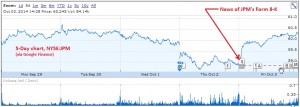JPMorgan’s Form 8-K to Investors: We’ve Been Hack-Mapped!
 JPMorgan’s Form 8-K filed on Thursday with the Securities and Exchange Commission advises:
JPMorgan’s Form 8-K filed on Thursday with the Securities and Exchange Commission advises:
On October 2, 2014, JPMorgan Chase & Co. (“JPMorgan Chase” or the “Firm”) updated information for its customers, on its Chase.com and JPMorganOnline websites and on the Chase and J.P. Morgan mobile applications, about the previously disclosed cyberattack against the Firm. The Firm disclosed that:
• User contact information – name, address, phone number and email address – and internal JPMorgan Chase information relating to such users have been compromised.
• The compromised data impacts approximately 76 million households and 7 million small businesses.
• However, there is no evidence that account information for such affected customers – account numbers, passwords, user IDs, dates of birth or Social Security numbers – was compromised during this attack.
• As of such date, the Firm continues not to have seen any unusual customer fraud related to this incident.
• JPMorgan Chase customers are not liable for unauthorized transactions on their account that they promptly alert the Firm to.
The Firm continues to vigilantly monitor the situation and is continuing to investigate the matter. In addition, the Firm is fully cooperating with government agencies in connection with their investigations.
According to ZDNet, a forensic security firm suggests the bank’s users’ accounts are now at greater risk of compromise and that password changes and two-factor authentication should be implemented to address the risk.
However, the 8-K’s wording indicates a different security risk altogether as the users’ passwords and Social Security numbers are not compromised.
The disclosure of information compromised combined with earlier reporting about the breach more closely matches a description of that collected by National Security Agency’s TREASURE MAP intelligence collection program. TREASURE MAP gathered information about networks including nodes, but not data created by users at the end nodes of the network. The application delineated the path to the ends. and physical ends, not merely virtual ends of the network. Read more →

![[photo: liebeslakritze via Flickr]](http://www.emptywheel.net/wp-content/uploads/2013/06/SpyGrafitti_liebeslakritze-Flickr_300pxw.jpg)
